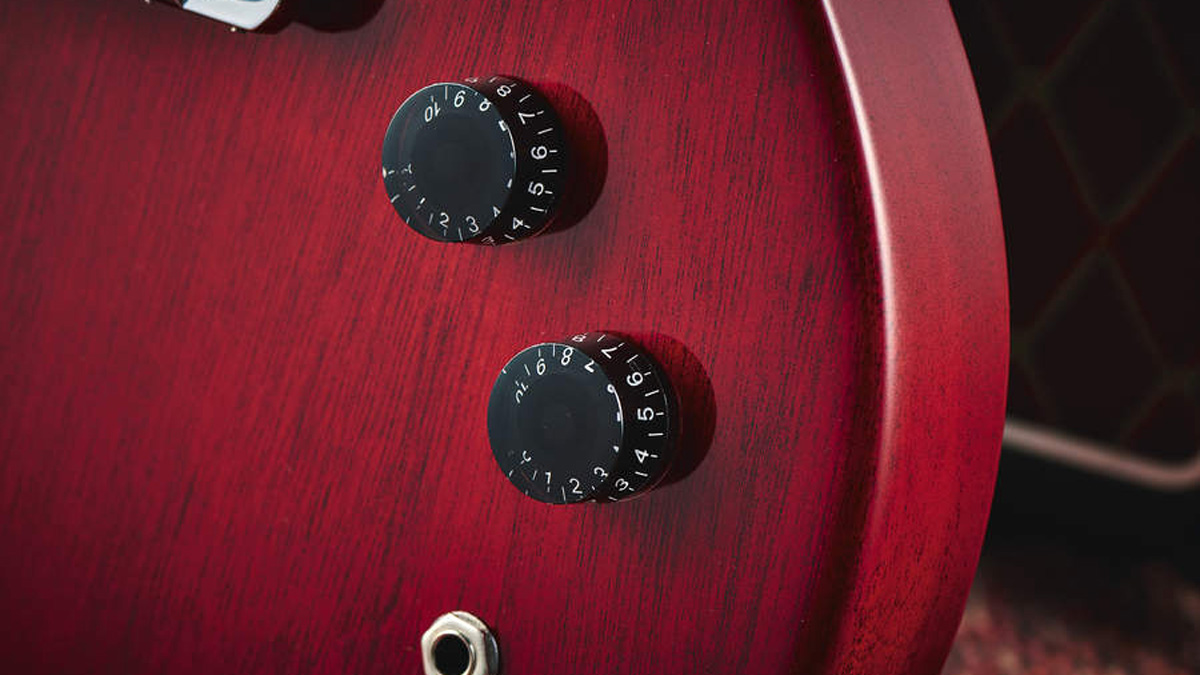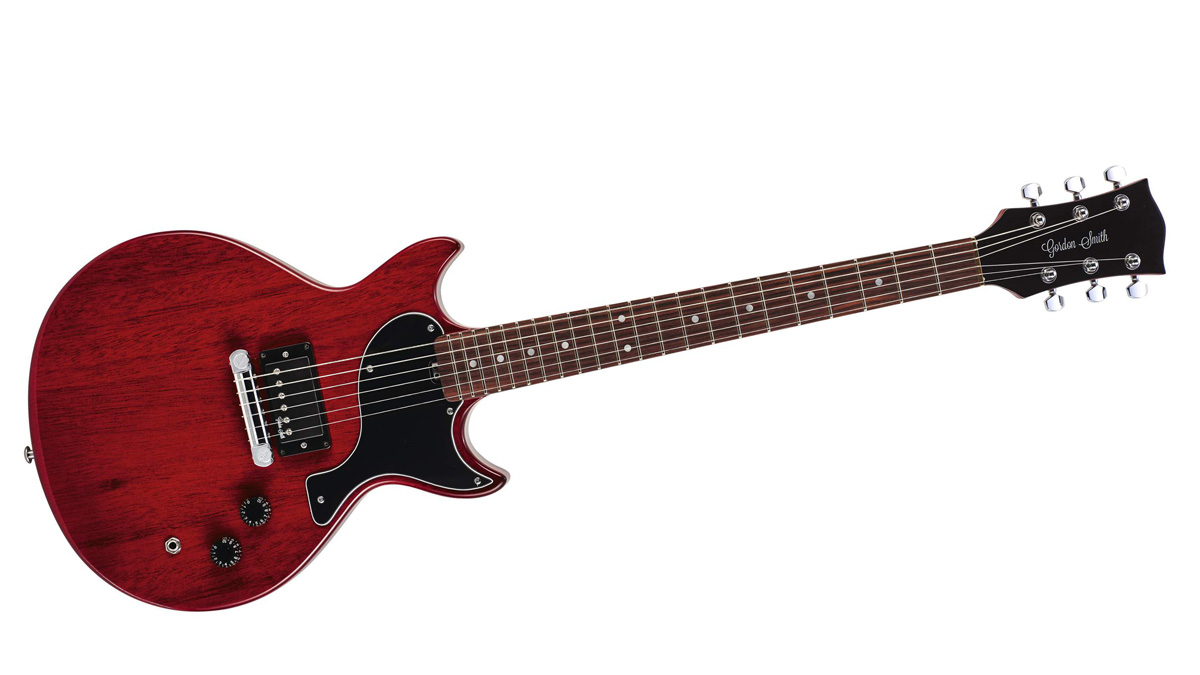MusicRadar Verdict
We’d strongly recommend you give this revitalised brand serious consideration.
Pros
- +
Build, resonance and versatile sounds from the single humbucker.
Cons
- -
The bar bridge might be too basic for some.
- -
There’s limited colour choice.
MusicRadar's got your back
You could easily dismiss Gordon Smith as a lesser, UK-made Gibson.
They share plenty in style and the GS1 - a sort of ‘Les Paul Jr meets Melody Maker’ - looks like it could have rolled off that Kalamazoo production line sometime during the 1960s. Back in the day, before new owners Auden took over the brand and when there was still a hyphen between Gordon and Smith, the numerous idiosyncrasies of GS founder John Smith often rose to the surface. But now, under the new manufacturing team, those seem to have been pared back, giving the impression of a more mainstream build.
Yet whichever view you take, do not underestimate the potential of Gordon Smith, not least here in this built-for-stock Heritage guitar. The GS1 is priced at £849 and this is not quite a Korean-made price, but great value for a British build of this quality. Indeed, value for money is a key reason why you might want to test the modern Gordon Smith recipe.
Design and Build
Built around the ‘correct’ Gibson scale of 625.5mm (which John Smith had measured and always used), this model has a double-cut Les Paul outline and is made in the thicker of two styles offered by GSG - the thin body version being just 36mm in depth. Here, the GS1 and the GS1000’s bodies are a shade over 44mm and are thick slabs of one-piece mahogany and Brazilian cedar respectively.
There are no comfort contours to the body and the GS1 ships with GS’s Fat mahogany neck. Again, like the body, one-piece stock (quarter sawn) appears to be used. There aren’t even any headstock widening wings.
This guitar sports a rosewood fingerboard with a 305mm radius and simple dot inlays with the medium jumbo wire, which measures 2.57mm wide with a height of approximately 1.24mm. There’s a visible wheel-type adjustment for the truss rod at the end of the neck - a new feature for the Auden era - along with a more conventional two-way truss rod.

Another new addition is the ‘tone pocket’. “I can’t tell you about that,” laughs Doug. “It’s something our team here has worked on and we believe it results in more contact between the neck and body at the point of the joint. It’s quite small if you look at it from a length point of view, but once you get inside the guitar, there is a flange that widens out to give more contact between the body and the neck beyond what you can see.”
Electrics
This model uses a version of John Smith’s humbucking design. This guitar uses original-style black plastic casings - with all the internal gubbins encapsulated into the cover. Magnet swaps or the like? Forget it. But, while we’re on the subject, John Smith always used ceramic (Barium ferrite) magnets that are still part of the current design. “Yes, these original Heritage-spec Gordon Smith humbuckers are wound exactly the same way, on the same machine that John used. But we also have a more modern winder purely because John’s original machine would never cope with the number of pickups we need today. So, along with that, we’ve been playing around with different winding patterns and balances across the two bobbins so that when you, for example, coil-split one of the pickups on the GS1000 you get less of a volume drop that traditionally you can get with coil splits.”
The controls also retain a twist or two from John Smith - the coil-split function is on the volume control (which voices the slug coil) not the more usual tone control, and the pickup circuit uses a pair of 0.022 microfarad tone capacitors and a pair of 0.002 microfarad ‘treble bleed’ caps that have been slightly tweaked compared to the pre-Auden wiring (certainly according to an original GSG wiring diagram we have).
Back then, as now, Gordon Smith does things slightly differently, but not without reason. “Our tone circuit is designed to give you a more usable tone roll-off. We want to try to make that humbucker as functional as it can be. A lot of players like the single pickup guitars, so we want that pickup to do as much as possible. We know we’ve got people out there in metal, rock, blues and country bands and they’re all doing it with those humbuckers.”
Spec and Sound
Weight-wise this guitar feels business-like but is not overly heavy. There’s an impressive acoustic ring and resonance. However, with the heel-placed upper-strap button, it does tend to tip forward a little, in a similar way to a Gibson SG.
The GS1’s neck comes in at a depth of 21.5mm. Moving up to the 12th fret, we measured depth of 25mm respectively. String spacing, incidentally, is 35.5mm at the nut.
The single-pickup GS1 sounds pretty punky in a Les Paul Jr fashion. It’s a refined piece and, if we’re honest, sounds like it too.
On one hand, you might simply want to swap out the pickups of this guitar and fit a more conventional control circuit - we’re sure it would sound superb. But the combination of GSG’s humbuckers with that quaintly idiosyncratic tone circuit gets to the heart of Gordon Smith. It’s a unique voice that, in the right hands, has huge potential.
If we step back from the heritage of the UK’s longest-running production guitar company for a moment and just consider this simply as a new guitar, one quality stands out proudly above all other virtues: excellent value for money.
Factor in the one-piece wood stock, smart build, good components and the unique and highly useable voicing and you have a proposition that’s hard to ignore.
The GS1 Heritage is a mean rock machine that will easily double as a quality spare or slide guitar with a resonance that’s rare to find at this price.
Dave Burrluck is one of the world’s most experienced guitar journalists, who started writing back in the '80s for International Musician and Recording World, co-founded The Guitar Magazine and has been the Gear Reviews Editor of Guitarist magazine for the past two decades. Along the way, Dave has been the sole author of The PRS Guitar Book and The Player's Guide to Guitar Maintenance as well as contributing to numerous other books on the electric guitar. Dave is an active gigging and recording musician and still finds time to make, repair and mod guitars, not least for Guitarist’s The Mod Squad.
With its latest free update, Ableton has finally turned Note into the app I always wanted it to be
Technically capable, but struggle to make your tunes sound musical? 5 simple music theory hacks to make your tracks stand out
"Despite its size, it delivers impressive audio quality and premium functions as well as featuring a good selection of inspired sounds": Roland GO:Piano 88PX review











